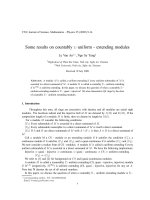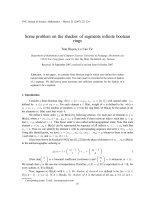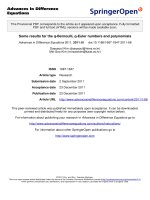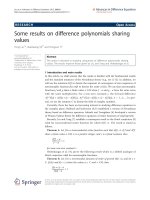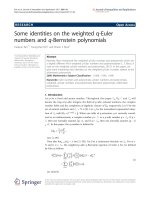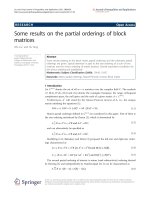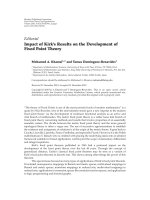SOME RESULTS ON THE FIFTH SINGER TRANSFER
Bạn đang xem bản rút gọn của tài liệu. Xem và tải ngay bản đầy đủ của tài liệu tại đây (344.92 KB, 12 trang )
SOME RESULTS ON THE FIFTH SINGER TRANSFER
NGUYEN SUM†,1 AND NGUYEN KHAC TIN‡
Abstract. We study the algebraic transfer constructed by Singer [16] using
technique of the hit problem. In this paper, we show that Singer’s conjecture
for the algebraic transfer is true in the case of five variables and degree r.2s − 5
with r = 3, 4 and s an arbitrary positive integer.
1. Introduction
Let Vk be an elementary abelian 2-group of rank k. Denote by BVk the classifying
space of Vk . It is well-known that
Pk := H ∗ (BVk ) ∼
= F2 [x1 , x2 , . . . , xk ],
a polynomial algebra in k variables x1 , x2 , . . . , xk , each of degree 1. Here the cohomology is taken with coefficients in the prime field F2 of two elements. Then, Pk is
a module over the mod-2 Steenrod algebra, A. The action of A on Pk is determined
by the elementary properties of the Steenrod squares Sq i and subject to the Cartan
formula (see Steenrod and Epstein [18]).
Let GLk be the general linear group over the field F2 . This group acts naturally
on Pk by matrix substitution. Since the two actions of A and GLk upon Pk commute
with each other, there is an inherited action of GLk on F2 ⊗A Pk .
Denote by (Pk )n the subspace of Pk consisting of all the homogeneous polynomials of degree n in Pk and by (F2 ⊗A Pk )n the subspace of F2 ⊗A Pk consisting
of all the classes represented by the elements in (Pk )n . In [16], Singer defined the
algebraic transfer, which is a homomorphism
GLk
ϕk : TorA
k,k+n (F2 , F2 ) → (F2 ⊗A Pk )n
from the homology of the mod-2 Steenrod algebra to the subspace of (F2 ⊗A Pk )n
consisting of all the GLk -invariant classes.
The Singer algebraic transfer was studied by many authors. (See Boardman [1],
Bruner-Ha-Hung [2], Ha [7], Hung [8, 9], Chon-Ha [4, 5, 6], Minami [13], Nam [14],
Hung-Quynh [10], Quynh [15], the first author [21] and others).
Singer showed in [16] that ϕk is an isomorphism for k = 1, 2. Boardman showed
in [1] that ϕ3 is also an isomorphism. However, for any k 4, ϕk is not a monomorphism in infinitely many degrees (see Singer [16], Hung [9]). Singer made the following conjecture.
Conjecture 1.1 (Singer [16]). The algebraic transfer ϕk is an epimorphism for
any k 0.
1
2
3
Corresponding author.
2000 Mathematics Subject Classification. Primary 55S10; 55S05.
Keywords and phrases: Steenrod squares, hit problem, algebraic transfer.
1
NGUYEN SUM†,1 AND NGUYEN KHAC TIN‡
2
The conjecture
verified for k = 4.
The purpose of
the main result of
is true for k
3. Based on the results in [19, 20], it can be
We hope that it is also true in this case.
the paper is to verify this conjecture for k = 5. The following is
the paper.
Theorem 1.2. Singer’s conjecture is true for k = 5 and n = r.2s − 5 with r = 3, 4
and s an arbitrary positive integer.
We prove this theorem by studying the F2 -vector space (F2 ⊗A P5 )GL5 . Based on
the results in [23, 24], we have the following.
5
Theorem 1.3. Let n be as in Theorem 1.2. Then, we have (F2 ⊗A P5 )GL
= 0.
n
Obviously, Theorem 1.3 implies Theorem 1.2. Note that for r = 4 and s = 2,
the above results are due to Quynh [15].
Furthermore, from the results of Tangora [22], Lin [12] and Chen [3], for r = 3,
s
Ext5,3.2
(F2 , F2 ) = 0. By passing to the dual, one gets TorA
5,3.2s (F2 , F2 ) = 0. Hence,
A
by Theorem 1.3, the homomorphism
GL5
ϕ5 : TorA
5,3.2s (F2 , F2 ) → (F2 ⊗A P5 )3.2s −5
is an isomorphism. For r = 4,
s
Ext5,4.2
(F2 , F2 ) =
A
P (h2 ) , if s = 2,
0,
otherwise.
By passing to the dual, we obtain
TorA
5,4.2s (F2 , F2 ) =
P (h2 )∗ , if s = 2,
0,
otherwise.
So, by Theorem 1.3, the homomorphism
GL5
ϕ5 : TorA
5,4.2s (F2 , F2 ) → (F2 ⊗A P5 )4.2s −5
is an epimorphism. However, it is not a monomorphism for s = 2.
In the remaining part of the paper we prove Theorem 1.3.
2. Preliminaries
In this section, we recall a result from Singer [17] which will be used in the next
section.
Let αi (a) denote the i-th coefficient in dyadic expansion of a non-negative integer
a. That means
a = α0 (a)20 + α1 (a)21 + α2 (a)22 + . . . ,
for αi (a) = 0, 1 and i
0.
Definition 2.1. For a monomial x = xa1 1 xa2 2 . . . xakk ∈ Pk , we define two sequences
associated with x by
ω(x) = (ω1 (x), ω2 (x), . . . , ωi (x), . . .), σ(x) = (a1 , a2 , . . . , ak ),
where ωi (x) = 1 j k αi−1 (aj ), i
1. The sequence ω(x) is called the weight
vector of x.
Let ω = (ω1 , ω2 , . . . , ωi , . . .) be a sequence of non-negative integers. The sequence
ω is called the weight vector if ωi = 0 for i
0.
SOME RESULTS ON THE FIFTH SINGER TRANSFER
3
The sets of all the weight vectors and the sigma vectors are given the left lexicographical order.
For a weight vector ω, we define deg ω = i>0 2i−1 ωi . Denote by Pk (ω) the
subspace of Pk spanned by monomials y such that deg y = deg ω, ω(y) ω, and by
Pk− (ω) the subspace of Pk spanned by monomials y ∈ Pk (ω) such that ω(y) < ω.
Definition 2.2. Let ω be a weight vector of degree n and f, g ∈ (Pk )n .
i) f ≡ g if and only if f − g ∈ A+ Pk . If f ≡ 0, then f is called hit.
ii) f ≡ω g if and only if f − g ∈ A+ Pk + Pk− (ω).
Obviously, the relations ≡ and ≡ω are equivalence ones. Note that if ω is a
minimal sequence of degree n, then f ≡ω g if and only if f ≡ g (see Theorem 2.4.)
Denote by QPk (ω) the quotient of Pk (ω) by the equivalence relation ≡ω . Then, we
have
QPk (ω) = Pk (ω)/((A+ Pk ∩ Pk (ω)) + Pk− (ω)).
It is easy to see that
QPk (ω) ∼
= QP ω := {[x] ∈ QPk : x is admissible and ω(x) = ω} .
k
So, we get
QPkω ∼
=
(F2 ⊗A Pk )n =
deg ω=n
QPk (ω).
deg ω=n
Hence, we can identify the vector space QPk (ω) with QPkω ⊂ QPk .
We note that the weight vector of a monomial is invariant under the permutation
of the generators xi , hence QPk (ω) has an action of the symmetric group Σk .
Furthermore, QPk (ω) is also an GLk -module.
For polynomials f ∈ Pk and g ∈ Pk (ω), we denote by [f ] the class in F2 ⊗A Pk
represented by f , and by [g]ω the class in QPk (ω) represented by g. For M ⊂ Pk
and S ⊂ Pk (ω), denote
[M ] = {[f ] : f ∈ M } and [S]ω = {[g]ω : g ∈ S}.
If ω is the minimal sequence, then [S]ω = [S] and [g]ω = [g].
Definition 2.3. A monomial z = xb11 xb22 . . . xbkk is called a spike if bj = 2sj − 1 for
sj a non-negative integer and j = 1, 2, . . . , k. If z is a spike with s1 > s2 > . . . >
sr−1 sr > 0 and sj = 0 for j > r, then it is called a minimal spike.
For a positive integer n, by µ(n) one means the smallest number r for which it
is possible to write n = 1 i r (2di − 1), where di > 0. In [17], Singer showed that
if µ(n) k, then there exists uniquely a minimal spike of degree n in Pk .
The following is a criterion for the hit monomials in Pk .
Theorem 2.4 (Singer [17]). Suppose x ∈ Pk is a monomial of degree n, where
µ(n) k. Let z be the minimal spike of degree n. If ω(x) < ω(z), then x is hit.
Definition 2.5. Let x, y be monomials of the same degree in Pk . We say that
x < y if and only if one of the following holds
i) ω(x) < ω(y);
ii) ω(x) = ω(y) and σ(x) < σ(y).
Definition 2.6. A monomial x is said to be inadmissible if there exist monomials
y1 , y2 , . . . , yt such that yj < x for j = 1, 2, . . . , t and x ≡ y1 + y2 + . . . + yt .
A monomial x is said to be admissible if it is not inadmissible.
NGUYEN SUM†,1 AND NGUYEN KHAC TIN‡
4
Obviously, the set of all the admissible monomials of degree n in Pk is a minimal
set of A-generators for Pk in degree n.
The proof of the following lemma is elementary.
Lemma 2.7.
i) All the spikes in Pk are admissible and their weight vectors are weakly decreasing.
ii) If a weight vector ω is weakly decreasing and ω1 k, then there is a spike z
in Pk such that ω(z) = ω.
One of the main tools in the study of the hit problem is Kameko’s homomorphism
0
Sq ∗
: F2 ⊗A Pk → F2 ⊗A Pk . This homomorphism is an GLk -homomorphism induced
0
by the F2 -linear map, also denoted by Sq ∗ : Pk → Pk , given by
0
Sq ∗ (x) =
y, if x = x1 x2 . . . xk y 2 ,
0, otherwise,
0
for any monomial x ∈ Pk . Note that Sq ∗ is not an A-homomorphism. However,
0
0
0
Sq ∗ Sq 2t = Sq t Sq ∗ , Sq ∗ Sq 2t+1 = 0
for any non-negative integer t.
0
Observe obviously that Sq ∗ is surjective on Pk and therefore on F2 ⊗A Pk . So,
one gets
0
dim(F2 ⊗A Pk )2m+k = dim Ker(Sq ∗ )(k,m) + dim(F2 ⊗A Pk )m ,
for any positive integer m. Here
0
(Sq ∗ )(k,m) : (F2 ⊗A Pk )2m+k → (F2 ⊗A Pk )m
0
denotes Kameko’s homomorphism Sq ∗ in degree 2m + k.
Theorem 2.8 (Kameko [11]). Let m be a positive integer. If µ(2m + k) = k, then
0
(Sq ∗ )(k,m) : (F2 ⊗A Pk )2m+k → (F2 ⊗A Pk )m
is an isomorphism of GLk -modules.
For 1 i k, define the A-homomorphism gi : Pk → Pk , which is determined
by gi (xi ) = xi−1 , gi (xi−1 ) = xi , gi (xj ) = xj for j = i, i − 1, 1
i < k, and
gk (x1 ) = x1 + x2 , gk (xj ) = xj for j > 1. Note that the general linear group GLk is
generated by the matrices associated with gi , 1 i k, and the symmetric group
Σk is generated by gi , 1 i < k.
So, a homogeneous polynomial f ∈ Pk is an GLk -invariant if and only if gi (f ) ≡ f
for 1 i k. If gi (f ) ≡ f for 1 i < k, then f is an Σk -invariant.
3. Proof of Theorem 1.3
From now on, we denote by Bk (n) the set of all admissible monomials of degree
n in Pk .
SOME RESULTS ON THE FIFTH SINGER TRANSFER
For any monomials z, z1 , z2 , . . . , zm in (Pk )n with m
Σk (z1 , z2 , . . . , zm ) = {σzt : σ ∈ Σk , 1
t
5
1, we denote
m} ⊂ (Pk )n ,
[B(z1 , z2 , . . . , zm )]ω = [Bk (n)]ω ∩ [Σk (z1 , z2 , . . . , zm )]ω ,
p(z) =
y.
y∈Bk (n)∩Σk (z)
If ω is the minimal sequence of degree n, then we write
[B(z1 , z2 , . . . , zm )]ω = [B(z1 , z2 , . . . , zm )].
3.1. The case r = 3.
For r = 3, we have n = 2s+1 + 2s − 5. If s > 3, then µ(n) = 5. Hence, using
Theorem 2.8, we see that the iterated Kameko’s homomorphism
0
s+1 +2s −5 −→ (F2 ⊗A P5 )19
(Sq ∗ )s−3
(5,3.2s−1 −5) : (F2 ⊗A P5 )2
is an isomorphism of the GL5 -modules. So, we need only to prove the theorem
for s = 1, 2, 3. For s = 1, we have n = 1. By a simple computation, one gets the
following.
5
Proposition 3.1.1. dim(F2 ⊗A P5 )1 = 5 and (F2 ⊗A P5 )GL
= 0.
1
For s = 2, we have n = 7.
5
Proposition 3.1.2. (F2 ⊗A P5 )GL
= 0.
7
Since Kameko’s homomorphism
0
(Sq ∗ )(5,1) : (F2 ⊗A P5 )7 −→ (F2 ⊗A P5 )1
5
is a homomorphism of GL5 -modules and (F2 ⊗A P5 )GL
= 0, we have
1
0
5
(F2 ⊗A P5 )GL
⊂ Ker(Sq ∗ )(5,1) .
7
0
From a result in [24], we see that dim(Ker(Sq ∗ )(5,1) ) = 105 with the basis
where
7
i=1 [B5 (ui )],
u1 = x71 , u2 = x1 x62 , u3 = x1 x22 x43 , u4 = x1 x32 x33 ,
u5 = x1 x22 x23 x24 , u6 = x1 x2 x23 x35 , u7 = x1 x2 x3 x24 x25 .
By a routine computation we obtained the following.
Lemma 3.1.3.
i) The subspaces [Σ5 (ui )] , 1
i
4, [Σ5 (u5 , u6 )] and [Σ5 (u7 )] are Σ5 submodules of (F2 ⊗A P5 )7 .
ii) We have the direct summand decompositions of the Σ5 -modules:
4
0
(Ker(Sq ∗ )(5,1) =
[Σ5 (ui )]
[Σ5 (u5 , u6 )]
Σ5 [(u7 )] .
i=1
Lemma 3.1.4. [Σ5 (ui )]
and [Σ5 (u7 )] Σ5 = 0.
Σ5
= [p(ui )] , i = 1, 2, 3, 4, [Σ5 (u5 , u6 )]
Σ5
= [p(u5 ]
NGUYEN SUM†,1 AND NGUYEN KHAC TIN‡
6
Proof. We compute [Σ5 (ui )] Σ5 for i = 3, 7. The others can be proved by a similar
computation.
Note that dim [Σ5 (u3 )] = 10 with a basis consisting of all the classes represented
by the following admissible monomials:
a1 = x3 x24 x45 , a2 = x2 x24 x45 , a3 = x2 x23 x45 , a4 = x2 x23 x44 , a5 = x1 x24 x45 ,
a6 = x1 x23 x45 , a7 = x1 x23 x44 , a8 = x1 x22 x45 , a9 = x1 x22 x44 , a10 = x1 x22 x43 .
10
j=1
Suppose p =
tion, one gets
γj aj and [p] ∈ [Σ5 (u3 )]
Σ5
with γj ∈ F2 . By a direct computa-
g1 (p) + p ≡ (γ2 + γ5 )(a2 + a5 ) + (γ3 + γ6 )(a3 + a6 ) + (γ4 + γ7 )(a4 + a7 ) ≡ 0,
g2 (p) + p ≡ (γ1 + γ2 )(a1 + a2 ) + (γ6 + γ8 )(a6 + a8 ) + (γ7 + γ9 )(a7 + a9 ) ≡ 0,
g3 (p) + p ≡ (γ2 + γ3 )(a2 + a3 ) + (γ5 + γ6 )(a5 + a6 ) + (γ9 + γ10 )(a9 + a10 ) ≡ 0,
g4 (p) + p ≡ (γ3 + γ4 )(a3 + a4 ) + (γ6 + γ7 )(a6 + a7 ) + (γ8 + γ9 )(a8 + a9 ) ≡ 0.
These relations imply γj = γ1 , for j = 2, 3, . . . , 10.
For i = 7, dim [Σ5 (u7 )] = 5, with a basis consisting of the classes represented
by the following admissible monomials:
b1 = x1 x2 x3 x24 x25 , b2 = x1 x2 x23 x4 x25 , b3 = x1 x2 x23 x24 x5 ,
b4 = x1 x22 x3 x4 x25 , b5 = x1 x22 x3 x24 x5 .
If q =
5
j=1
γj [bj ] ∈ [Σ5 (u7 )]
Σ5
with γj ∈ F2 , then
g1 (q) + q ≡ (γ4 + γ5 )b1 + γ4 b2 + γ5 b3 ≡ 0.
This implies γ4 = γ5 = 0. So, q = γ1 b1 + γ2 b2 + γ3 b3 . A simple computation shows
g2 (q) + q ≡ γ2 (b2 + b4 ) + γ3 )(b3 + b5 ) ≡ 0,
g3 (q) + q ≡ (γ1 + γ2 )(b1 + b2 ) ≡ 0.
From the last equalities, we get γ1 = γ2 = γ3 = 0.
5
Proof of Proposition 3.1.2. Let f ∈ (P5 )7 such that [f ] ∈ (F2 ⊗A P5 )GL
. Since
7
Σ5
[f ] ∈ (F2 ⊗A P5 )7 , using Proposition 3.1.1, Lemmas 3.1.3 and 3.1.4, we have f ≡
5
j=1 γj p(uj ) with γj ∈ F2 . By computing g5 (f ) + f in terms of the admissible
monomials, we obtain
g5 (f ) + f ≡ (γ1 + γ2 )x72 + (γ2 + γ3 + γ5 )x2 x63 + (γ3 + γ4 )x2 x23 x44
+ γ4 x2 x23 x24 x25 + γ5 x1 x33 x33 + other terms ≡ 0.
This relation implies γj = 0 for 1
j
5. The proposition is proved.
We now prove Theorem 1.3 for r = 3 and s = 3. Then, we have n = 19.
0
Since Kameko’s homomorphism (Sq ∗ )(5,7) : (F2 ⊗A P5 )19 −→ (F2 ⊗A P5 )7 is a
5
5
homomorphism of GL5 -module and (F2 ⊗A P5 )GL
= 0, we have (F2 ⊗A P5 )GL
⊂
7
7
0
0
Ker(Sq ∗ )(5,7) . From a result in [24], we see that dim(Ker(Sq ∗ )(5,7) ) = 802 and
0
Ker(Sq ∗ )(5,7) ∼
= QP5 (ω)
QP5 (¯
ω)
QP5 (ω).
Here ω = (3, 2, 1, 1), ω
¯ = (3, 2, 3) and ω = (3, 4, 2).
Proposition 3.1.5. QP5 (ω)GL5 = 0 and QP5 (¯
ω )GL5 = 0.
SOME RESULTS ON THE FIFTH SINGER TRANSFER
7
3
According to a result in [24], dim(QP5 (ω)) = 55 with the basis j=1 [B5 (vj )]ω ,
where
v1 = x1 x22 x23 x74 x75 , v2 = x1 x22 x33 x64 x75 , v3 = x1 x32 x33 x64 x65 ;
dim(QP5 (¯
ω )) = 47 with the basis
6
¯,
j=4 [B5 (vj )]ω
where
v4 = x1 x22 x43 x54 x75 , v5 = x1 x22 x33 x64 x75 , v6 = x21 x32 x43 x54 x55 .
By a simple computation using technique as given in the proof of Lemma 3.1.4, we
obtain the following.
Lemma 3.1.6.
i) The subspaces [Σ5 (vi )]ω , i = 1, 2, 3, are Σ5 -submodules of QP5 (ω); [Σ5 (v4 )]ω¯
and [Σ5 (v5 , v6 )]ω¯ are Σ5 -submodules of QP5 (¯
ω ).
ii) We have the direct summand decompositions of the Σ5 -modules:
QP5 (ω) = [Σ5 (v1 )]ω
[Σ5 (v2 )]ω
QP5 (¯
ω ) = [Σ5 (v4 )]ω¯
[Σ5 (v5 , v6 )]ω¯ .
[Σ5 (v3 )]ω ,
Lemma 3.1.7. We have
[Σ5 (vi )]ω
Σ5
= [p(vi )]ω , i = 1, 2, 3,
[Σ5 (v4 )]ω¯
Σ5
= [p(v4 )]ω¯ , [Σ5 (v5 , v6 )]ω¯
Σ5
= 0.
Proof of Proposition 3.1.5. Let p ∈ (P5 )19 such that [p]ω ∈ QP5 (ω)GL5 . Since
3
[p]ω ∈ QP5 (ω)Σ5 , using Lemma 3.1.6, one gets p ≡ω
j=1 γj p(vj ) with γj ∈ F2 .
By computing g5 (p) + p in terms of the admissible monomials, we obtain
g5 (p) + p ≡ω (γ1 + γ2 )x1 x72 x23 x24 x75 + γ2 x1 x32 x23 x64 x75
+ γ3 x1 x33 x33 x64 x65 + other terms ≡ω 0.
The last equality implies γ1 = γ2 = γ3 = 0.
ω )Σ5 , using
Now, let q ∈ (P5 )19 such that [p]ω¯ ∈ QP5 (¯
ω )GL5 . Since [p]ω¯ ∈ QP5 (¯
Lemma 3.1.6, we have q ≡ω¯ γp(v4 ) with γ ∈ F2 . By a direct computation, we get
g5 (q) + q ≡ω¯ γx1 x33 x43 x44 x75 + other terms ≡ω¯ 0.
From this relation it implies γ = 0. The proposition follows.
5
Using Propositions 3.1.2 and 3.1.5, we obtain (F2 ⊗A P5 )GL
= QP5 (ω)GL5 . In
19
the remain part of this subsection, we prove the following.
Proposition 3.1.8. QP5 (ω)GL5 = 0.
Based on the results in [24], we see that dim QP5 (ω) = 700 with the basis
where
10
j=1 [B5 (wj )]ω ,
7 11
3 7 9
2 15
w1 = x1 x32 x15
3 , w2 = x1 x2 x3 , w3 = x1 x2 x3 , w4 = x1 x2 x3 x4 ,
2 3 13
w5 = x1 x32 x63 x94 , w6 = x1 x2 x23 x44 x11
5 , w7 = x1 x2 x3 x4 ,
2 3 5 8
w8 = x1 x2 x23 x64 x95 , w9 = x1 x32 x43 x11
4 , w10 = x1 x2 x3 x4 x5 .
By a direct computation, using technique as given in the proof of Lemma 3.1.4,
we obtain the following lemmas.
NGUYEN SUM†,1 AND NGUYEN KHAC TIN‡
8
Lemma 3.1.9.
i) The subspaces [Σ5 (wi )] , 1
i
6, [Σ5 (w7 , w9 )] and [Σ5 (w8 , w10 )] are
Σ5 -submodules of QP5 (ω).
ii) We have a direct summand decomposition of the Σ5 -modules:
6
QP5 (ω) =
[Σ5 (wi )]
[Σ5 (w7 , w9 )]
[Σ5 (w8 , w10 )] .
i=1
Lemma 3.1.10. We have
i) [Σ5 (wi )] Σ5 = [p(ui )] , for i = 1, 2 and [Σ5 (w4 )]
ii) [Σ5 (w3 )] Σ5 = [p(1,ω) ] , where
Σ5
= [Σ5 (w6 )]
Σ5
= 0.
3 13 3
7 3 9
7 9 3
x3i x3j x13
t + xi xj xt + xi xj xt + xi xj xt .
p(1,ω) =
1 i
iii) [Σ5 (w5 )]
Σ5
= [p(2,ω) ] , where
3
6 9
3 3 4 9
3 3 5 8
x3i xj x5t x10
u + xi xj xt xu + xi xj xt xu + xi xj xt xu
p(2,ω) =
1 i
6 3 9
3 4 3 9
3 5 2 9
3 5 3 8
xi x3j x3t x12
u + xi xj xt xu + xi xj xt xu + xi xj xt xu + xi xj xt xu .
+
1 i
iv) [Σ5 (w7 , w9 )]
Σ5
= [p(3,ω) + p(4,ω) ], [p(4,ω) + p(5,ω) ] , where
7
3 8
xi xj x3t x14
u + xi xj xt xu ,
p(3,ω) =
1 i
3 13
2
7
10
7 9
2
x3i xj xt x14
u + xi xj xt xu + xi xj xt xu + xi xj xt xu ,
p(4,ω) =
1 i
7 10
3
4 11
3
7 8
xi xj x6t x11
u + xi xj xt xu + xi xj xt xu + xi xj xt xu .
p(5,ω) =
1 i
v) [Σ5 (w8 , w10 )]
Σ5
= [p(6,ω) ], [p(7,ω) ] , where
3
4 10
3
6 8
6
10
p(6,ω) = x1 x2 x3 x64 x10
5 + x1 x2 x3 x4 x5 + x1 x2 x3 x4 x5 + x1 x2 x3 x4 x5
6
10
6
10
3 12
2
+ x1 x2 x63 x10
4 x5 + x1 x2 x3 x4 x5 + x1 x2 x3 x4 x5 + x1 x2 x3 x4 x5
2
6 9
2
6 9 2
3
4
10
+ x1 x32 x12
3 x4 x5 + x1 x2 x3 x4 x5 + x1 x2 x3 x4 x5 + x1 x2 x3 x4 x5
3 4
10
3 4
10
3 6
8
+ x31 x2 x43 x10
4 x5 + x1 x2 x3 x4 x5 + x1 x2 x3 x4 x5 + x1 x2 x3 x4 x5
+ x1 x32 x63 x84 x5 + x31 x2 x63 x4 x85 + x31 x2 x63 x84 x5 + x31 x42 x93 x4 x25
+ x31 x42 x93 x24 x5 + x1 x32 x53 x24 x85 + x1 x32 x53 x84 x25 + x31 x52 x3 x24 x85
+ x31 x52 x3 x84 x25 + x31 x52 x23 x4 x85 + x31 x52 x23 x84 x5 + x31 x52 x83 x4 x25
+ x31 x52 x83 x24 x5 .
SOME RESULTS ON THE FIFTH SINGER TRANSFER
9
6 10
3 12 2
2 5 10
p(7,ω) = x1 x2 x63 x4 x10
5 + x1 x2 x3 x4 x5 + x1 x2 x3 x4 x5 + x1 x2 x3 x4 x5
2
6 9
6 3 8
6 8 3
+ x1 x22 x3 x54 x10
5 + x1 x2 x3 x4 x5 + x1 x2 x3 x4 x5 + x1 x2 x3 x4 x5
2 12 3
+ x1 x22 x53 x24 x95 + x1 x22 x53 x94 x25 + x1 x2 x23 x34 x12
5 + x1 x2 x3 x4 x5
2 6 9
6 2 9
6 9 2
+ x1 x2 x33 x24 x12
5 + x1 x2 x3 x4 x5 + x1 x2 x3 x4 x5 + x1 x2 x3 x4 x5
3 4
10
3 4 10
3
6 8
+ x1 x32 x3 x44 x10
5 + x1 x2 x3 x4 x5 + x1 x2 x3 x4 x5 + x1 x2 x3 x4 x5
+ x1 x32 x63 x4 x85 + x1 x32 x63 x84 x5 + x1 x32 x33 x44 x85 + x1 x32 x43 x34 x85
+ x1 x32 x43 x84 x35 + x31 x2 x33 x44 x85 + x31 x2 x43 x34 x85 + x31 x2 x43 x84 x35
+ x31 x32 x3 x44 x85 + x31 x32 x43 x4 x85 + x31 x32 x43 x84 x5 + x1 x22 x3 x34 x12
5
3
2 3
12
2 3 12
2 12
3
+ x1 x22 x3 x12
4 x5 + x1 x2 x3 x4 x5 + x1 x2 x3 x4 x5 + x1 x2 x3 x4 x5
3
6
3 8
6
8 3
6 3
8
+ x1 x22 x12
3 x4 x5 + x1 x2 x3 x4 x5 + x1 x2 x3 x4 x5 + x1 x2 x3 x4 x5
+ x1 x62 x33 x84 x5 + x1 x62 x83 x4 x35 + x1 x62 x83 x34 x5 + x1 x22 x33 x44 x95
+ x1 x22 x43 x34 x95 + x1 x22 x43 x94 x35 + x1 x22 x33 x54 x85 + x1 x22 x53 x34 x85
+ x1 x22 x53 x84 x35 + x31 x42 x3 x34 x85 + x31 x42 x3 x84 x35 + x31 x42 x33 x4 x85
+ x31 x42 x33 x84 x5 + x31 x42 x83 x4 x35 + x31 x42 x83 x34 x5 .
Proof of Proposition 3.1.8. Let f ∈ (P5 )19 such that [f ] ∈ QP5 (ω)GL5 . Since [f ] ∈
QP5 (ω)Σ5 , using Lemmas 3.1.9 and 3.1.10, we have
f ≡ γ1 p(u1 ) + γ2 p(u2 ) + γ3 p(1,ω) + γ4 p(2,ω)
+ γ5 (p(3,ω) + p(4,ω) ) + γ6 (p(4,ω) + p(5,ω) ) + γ7 p(6,ω) + γ8 p(7,ω) ,
with γj ∈ F2 . By computing g5 (f ) + f in terms of the admissible monomials, we
obtain
7 11
3 14
g5 (f ) + f ≡ γ1 x1 x32 x15
3 + γ2 x1 x2 x3 + γ3 x1 x2 x3 x4
3
14
3
7
10
+ γ4 x1 x32 x12
3 x4 + γ5 x1 x2 x3 x4 + γ6 x1 x2 x3 x4
+ γ7 x1 x72 x3 x24 x85 + γ8 x1 x32 x33 x44 x85 + other terms ≡ 0.
This relation implies γj = 0 for 1
j
8. The proposition is proved.
5
Combining the above results, we get (F2 ⊗A P5 )GL
3.2s −5 = 0. So, Theorem 1.3 is
proved for the case r = 3.
3.2. The case r = 4.
For r = 4, we have n = 2s+2 − 5. If s > 2, then µ(2s+2 − 5) = 5. Using Theorem
2.8, we see that the iterated Kameko’s homomorphism
0
s+2 −5 −→ (F2 ⊗A P5 )11
(Sq ∗ )s−2
(5,2s+1 −5) : (F2 ⊗A P5 )2
is an isomorphism. So, we need only to prove the theorem for s = 1, 2. For s = 1,
we have n = 3. By a simple computation, we obtain
5
Proposition 3.2.1. dim(F2 ⊗A P5 )3 = 25 and (F2 ⊗A P5 )GL
= 0.
3
For s = 2, we have n = 11. Since Kameko’s homomorphism
0
(Sq ∗ )(5,3) : (F2 ⊗A P5 )11 −→ (F2 ⊗A P5 )3
NGUYEN SUM†,1 AND NGUYEN KHAC TIN‡
10
5
5
⊂
= 0, we have (F2 ⊗A P5 )GL
is a homomorphism of GL5 -module and (F2 ⊗A P5 )GL
11
3
0
Ker(Sq ∗ )(5,3) . From the results in [23], we see that
0
Ker(Sq ∗ )(5,3) = QP5 (3, 2, 1)
QP5 (3, 4)
and dim QP5 (3, 4) = 10. By a direct computation, using the admissible monomial
basis of QP5 (3, 4), we easily obtain the following.
Proposition 3.2.2. QP5 (3, 4)GL5 = 0.
Now, we compute QP5 (3, 2, 1)GL5 . From the results in [23], we can see that
5
dim QP5 (3, 2, 1) = 280 with the basis i=1 [B(¯
ui )], where
u
¯1 = x1 x32 x73 , u
¯2 = x31 x32 x53 , u
¯3 = x1 x2 x23 x74 ,
u
¯4 = x1 x22 x33 x54 , u
¯5 = x1 x2 x23 x34 x45 .
A simple computation, using the results in [23], one gets the following.
Lemma 3.2.3.
i) The subspaces [Σ5 (¯
ui )] , 1 i 5, are Σ5 -submodules of (F2 ⊗A P5 )11 .
ii) We have a direct summand decomposition of the Σ5 -modules:
5
QP5 (3, 2, 1) =
[Σ5 (¯
ui )] .
i=1
Lemma 3.2.4. We have
i) [Σ5 (¯
u1 )] Σ5 = [p(¯
u1 )] , [Σ5 (¯
ui )]
p] , where
ii) [Σ5 (¯
u4 )] Σ5 = [¯
Σ5
= 0 for i = 2, 3, 5.
xi xj x3t x6u + x3i xj x3t x4u .
p¯ =
1 i
Proof. We prove that [Σ5 (¯
u2 )] Σ5 = 0. The others can be proved by a similar
computation.
From the result in [23], [Σ5 (¯
u2 )] is an F2 -vector space of dimension 20 with a
basis consisting of all the classes represented by the following admissible monomials:
a1 = x33 x34 x55
a5 = x32 x33 x55
a9 = x31 x34 x55
a13 = x31 x53 x35
a17 = x31 x32 x53
a2 = x33 x54 x35
a6 = x32 x33 x54
a10 = x31 x54 x35
a14 = x31 x53 x34
a18 = x31 x52 x35
a3 = x32 x34 x55
a7 = x32 x53 x35
a11 = x31 x33 x55
a15 = x31 x32 x55
a19 = x31 x52 x34
a4 = x32 x54 x35
a8 = x32 x53 x34
a12 = x31 x33 x54
a16 = x31 x32 x54
a20 = x31 x52 x33 .
Suppose that p is a polynomial such that [p] ∈ [Σ5 (¯
u2 )]
p≡
γi ai ,
1 i 20
Σ5
and
SOME RESULTS ON THE FIFTH SINGER TRANSFER
where γi ∈ F2 , 1
i
11
20. By a direct computation, we obtain
g1 (p) + p ≡ (γ3 + γ9 )a3 + (γ4 + γ10 )a4 + (γ5 + γ11 )a5 + (γ6 + γ12 )a6
+ (γ7 + γ13 )a7 + (γ8 + γ14 )a8 + (γ3 + γ9 )a9 + (γ4 + γ10 )a10
+ (γ5 + γ11 )a11 + (γ6 + γ12 )a12 + (γ7 + γ13 )a13
+ (γ8 + γ14 )a14 + γ18 a15 + γ19 a16 + γ20 a17 ≡ 0,
g2 (p) + p ≡ (γ1 + γ3 )a1 + (γ2 + γ4 )a2 + (γ1 + γ3 )a3 + (γ2 + γ4 )a4 + γ7 a5
+ γ8 a6 + (γ11 + γ15 )a11 + (γ12 + γ16 )a12 + (γ13 + γ18 )a13
+ (γ14 + γ19 )a14 + (γ11 + γ15 )a15 + (γ12 + γ16 )a16 + (γ17 + γ20 )a17
+ (γ13 + γ18 )a18 + (γ14 + γ19 )a19 + (γ17 + γ20 )a20 ≡ 0.
These relations imply γi = 0 for i = 7, 8, 13, 14, 17, 18, 19, 20. From this we get
g3 (p) + p ≡ γ2 a1 + (γ3 + γ5 )a3 + γ4 a4 + (γ3 + γ5 )a5 + γ6 a6
+ γ4 a7 + γ6 a8 + (γ9 + γ11 )a9 + γ10 a10 + (γ9 + γ11 )a11
+ γ12 a12 + γ10 a13 + γ12 a14 + γ16 a16 + γ16 a17 ≡ 0,
g4 (p) + p ≡ (γ1 + γ2 )a1 + (γ1 + γ2 )a2 + (γ3 + γ4 )a3 + (γ3 + γ4 )a4 + (γ5 + γ6 )a5
+ (γ5 + γ6 )a6 + (γ9 + γ10 )a9 + (γ9 + γ10 )a10 + (γ11 + γ12 )a11
+ (γ11 + γ12 )a12 + (γ15 + γ16 )a15 + (γ15 + γ16 )a16 ≡ 0.
Combining the above equalities gives γi = 0 for i = 1, 2, . . . , 20.
Proposition 3.2.5. QP5 (3, 2, 1)GL5 = 0.
Proof. Let h ∈ (P5 )11 such that [h] ∈ QP5 (3, 2, 1)GL5 . Since [h] ∈ QP5 (3, 2, 1)Σ5 ,
using Lemmas 3.2.3 and 3.2.4, we have
h ≡ γ1 p(¯
u1 ) + γ2 p¯,
with γ1 , γ2 ∈ F2 . Computing g5 (h) + h in terms of the admissible monomials, we
obtain
g5 (h) + h ≡ γ1 x1 x32 x73 + γ2 x1 x2 x23 x24 x55 + other terms ≡ 0.
This relation implies γ1 = γ2 = 0, hence h = 0. The proposition is proved.
5
From Propositions 3.2.1, 3.2.2 and 3.2.5, we get (F2 ⊗A P5 )GL
2s+2 −5 = 0 for all
s 1. Theorem 1.3 is completely proved.
Acknowledgment. The paper was completed when the first author was visiting
to Vietnam Institute for Advanced Study in Mathematics (VIASM). He would like
to thank the VIASM for support and kind hospitality.
References
[1] J. M. Boardman, Modular representations on the homology of power of real projective space,
in: M. C. Tangora (Ed.), Algebraic Topology, Oaxtepec, 1991, in: Contemp. Math., vol. 146,
1993, pp. 49-70, MR1224907.
[2] R. R. Bruner, L. M. Ha and N. H. V. Hung, On behavior of the algebraic transfer, Trans.
Amer. Math. Soc. 357 (2005), 473-487, MR2095619.
[3] T. W. Chen, Determination of Ext5,∗
A (Z/2, Z/2), Topology Appl., 158 (2011), 660-689,
MR2774051.
[4] P. H. Chon and L. M. Ha, Lambda algebra and the Singer transfer, C. R. Math. Acad. Sci.
Paris 349 (2011), 21-23, MR2755689.
NGUYEN SUM†,1 AND NGUYEN KHAC TIN‡
12
[5] P. H. Chon and L. M. Ha, On May spectral sequence and the algebraic transfer, Manuscripta
Math. 138 (2012), 141-160, MR2898751.
[6] P. H. Chon and L. M. Ha, On the May spectral sequence and the algebraic transfer II,
Topology Appl. 178 (2014), 372-383, MR3276753.
[7] L. M. Ha, Sub-Hopf algebras of the Steenrod algebra and the Singer transfer, “Proceedings of
the International School and Conference in Algebraic Topology, Ha Noi 2004”, Geom. Topol.
Monogr., Geom. Topol. Publ., Coventry, vol. 11 (2007), 81-105, MR2402802.
[8] N. H. V. Hung, The weak conjecture on spherical classes, Math. Zeit. 231 (1999), 727-743,
MR1709493
[9] N. H. V. Hung, The cohomology of the Steenrod algebra and representations of the general
linear groups, Trans. Amer. Math. Soc. 357 (2005), 4065-4089, MR2159700.
[10] N. H. V. Hung and V. T. N. Quynh, The image of Singer’s fourth transfer, C. R. Math.
Acad. Sci. Paris 347 (2009), 1415-1418, MR2588792.
[11] M. Kameko, Products of projective spaces as Steenrod modules, PhD Thesis, The Johns
Hopkins University, ProQuest LLC, Ann Arbor, MI, 1990. 29 pp, MR2638633.
5,∗
[12] W. H. Lin, Ext4,∗
A (Z/2, Z/2) and ExtA (Z/2, Z/2), Topology Appl., 155 (2008), 459-496,
MR2380930.
[13] N. Minami, The iterated transfer analogue of the new doomsday conjecture, Trans. Amer.
Math. Soc. 351 (1999), 2325-2351, MR1443884.
[14] T. N. Nam, Transfert alg´
ebrique et action du groupe lin´
eaire sur les puissances divis´
ees
modulo 2, Ann. Inst. Fourier (Grenoble) 58 (2008), 1785-1837, MR2445834.
[15] V. T. N. Quynh, On behavior of the fifth algebraic transfer, “Proceedings of the International
School and Conference in Algebraic Topology, Ha Noi 2004”, Geom. Topol. Monogr., Geom.
Topol. Publ., Coventry, vol. 11 (2007), 309-326, MR2402811.
[16] W. M. Singer, The transfer in homological algebra, Math. Zeit. 202 (1989), 493-523,
MR1022818.
[17] W. M. Singer, On the action of the Steenrod squares on polynomial algebras, Proc. Amer.
Math. Soc. 111 (1991), 577-583, MR1045150.
[18] N. E. Steenrod and D. B. A. Epstein, Cohomology operations, Annals of Mathematics Studies
50, Princeton University Press, Princeton N.J (1962), MR0145525.
[19] N. Sum, The negative answer to Kameko’s conjecture on the hit problem, Adv. Math. 225
(2010), 2365-2390, MR2680169.
[20] N. Sum, On the Peterson hit problem, Adv. Math. 274 (2015), 432-489, MR3318156.
[21] N. Sum, On the Peterson hit problem of five variables and its applications to the fifth Singer
transfer, East-West J. of Mathematics, 16(2014), 47-62.
[22] M. C. Tangora, On the cohomology of the Steenrod algebra, Math.Zeit. 116 (1970), 18-64,
MR0266205.
[23] N. K. Tin, The admissible monomial basis for the polynomial algebra of five variables in
degree eleven, Journal of Science, Quy Nhon University, 6 (2012), 81-89.
[24] N. K. Tin, The admissible monomial basis for the polynomial algebra of five variables in
degree 2s+1 + 2s − 5, East-West J. of Mathematics, 16 (2014), 34-46.
†
Department of Mathematics, Quy Nhon University,
170 An Duong Vuong, Quy Nhon, Binh Dinh, Viet Nam.
E-mail:
‡
Department of Foundation Sciences,
University of Technical Education of Ho Chi Minh City,
01 Vo Van Ngan, Thu Duc District, Ho Chi Minh City, Viet Nam.
Email:
